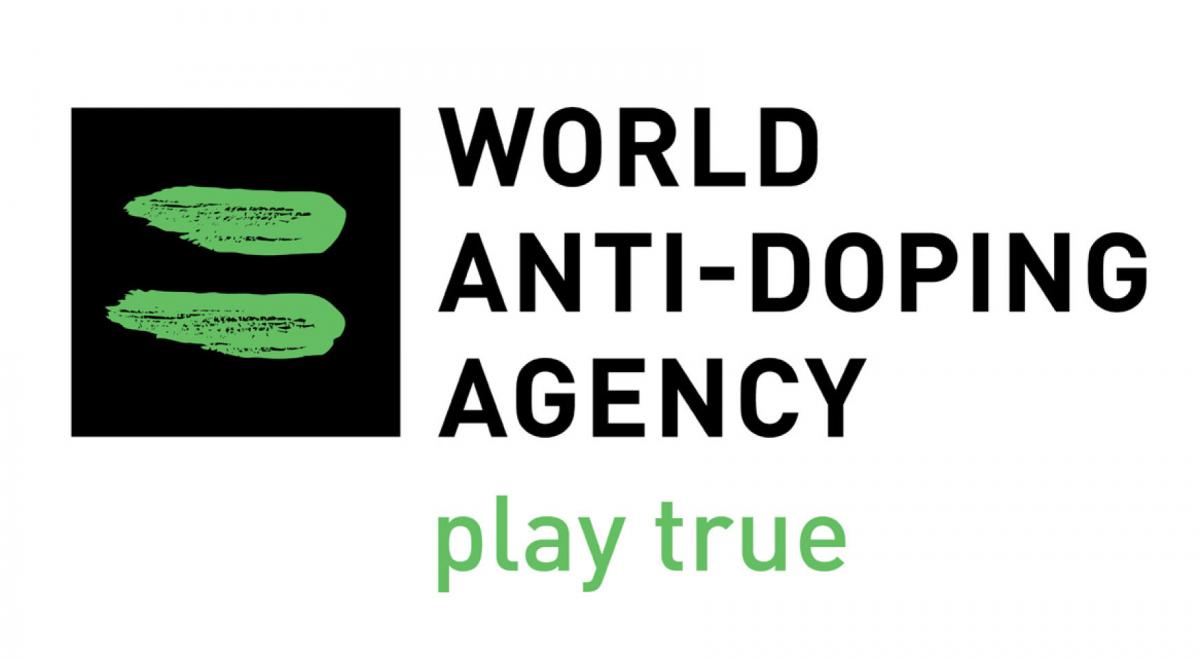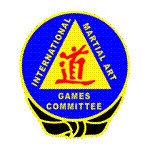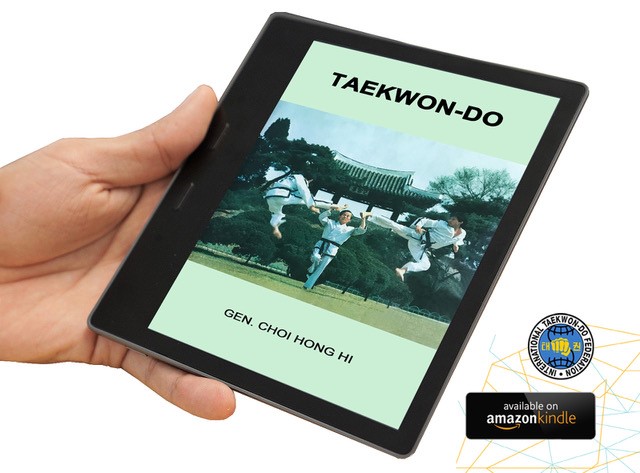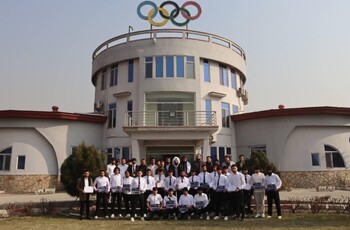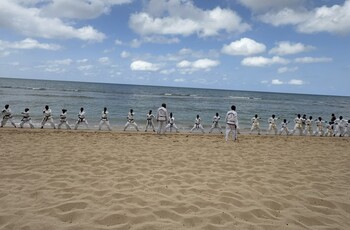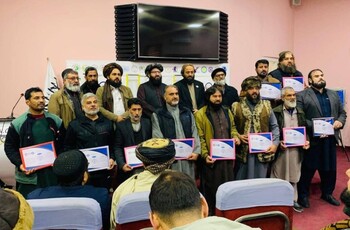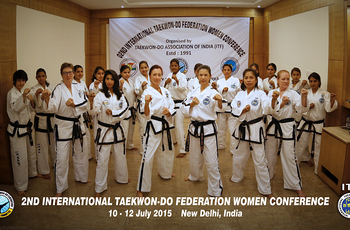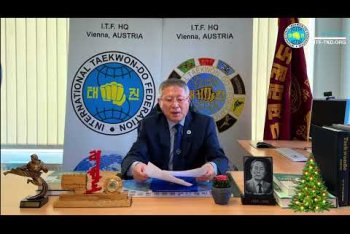International Taekwon‑Do Federation

For some time now, the International Taekwon‑Do Federation (ITF) and World Taekwondo (WT) have come closer together. The two governing bodies of Taekwondo signed a Protocol of Accord and held several joint demonstrations, most notably at the opening ceremony of the 2018 Winter Olympics in Pyeongchang, South Korea and this year at the Olympic Museum in Lausanne, Switzerland. Therefore, it is high time to introduce the ITF to our readers. In July we had the chance to talk to Professor Ri Yong Son, President of ITF, at the federation’s headquarters in Vienna.
Taekwondo Aktuell: Professor Ri would you tell us a little bit about yourself – for example, how did your history with Taekwon‑Do begin?
President Ri: Yes, of course. I am 55 years old, born on April 16, 1964 in Chongjin in the Northern Province of DPR of Korea. For five years I studied sport at Kim Il Sung University in Pyongyang. After that I officially joined the ITF demonstration team and had many chances to meet General Choi Hong Hi, the founder of Taekwon‑Do. For six years, until 1995 I was a member of the team and travelled to several countries like Russia, Uzbekistan, Poland, Bulgaria, Czechia and others – General Choi most of the time accompanied us.

President Ri (front left) as a member of the ITF demonstration team. Standing behind President Ri is General Choi Hong Hi.
Taekwondo Aktuell: How did your career in the International Taekwon‑Do Federation develop?
President Ri: In 1996 I moved to Vienna as treasurer of ITF and remained in this position until 2000. In June 2000 I returned home and became Secretary General of the Korea Taekwon‑Do Committee. In 2002 General Choi unexpectedly passed away – and his last words to me were: “Return to Vienna”. This I did and there I served as Director General of ITF. For more than ten years I worked in this position together with the second President of ITF, Professor Chang Ung. Together with him I visited Lausanne several times. The IOC supported a closer relation between ITF and World Taekwondo Federation (WTF), as WT was called then, and since 2005 there were official talks between the two bodies, which was a very good experience. Then, in 2012 I voluntarily left Vienna, as I had been far away from my family for quite a long time. I served as Vice President for the Korean Taekwon‑Do Committee until 2015, when I was elected 3rd President of ITF in Plovdiv, Bulgaria. Incidentally, this year’s World Championship will take place in Plovdiv, which awakens many fond memories in me.

The ITF leaders: Finance and Administration Director: Master Kim Cholgyu, President: Professor Ri Yong Son, Secretary General: Professor Kim Sung Hwan
Taekwondo Aktuell: On ITF’s website I found the expression “original Taekwon‑Do”. And actually, I think that is what many people feel, event non-ITF-members: That nowadays ITF Taekwon‑Do is closer to the roots of the sport than other styles. But what does “original Taekwon‑Do” mean for ITF and for you?
President Ri: On April 11, 1955 Taekwon‑Do was founded and in March 22, 1966 the International Taekwon‑Do Federation was established in Seoul, South Korea. Unfortunately, in 1972 the ITF headquarters moved to Canada and in 1973 the WTF was founded. Basically, that is the reason why we call ITF Taekwon‑Do the original – because it existed first.
Even in the beginning there were different techniques and rules in ITF and WTF Taekwondo. Dr. Un-Yong Kim, the founder and first president of WTF had good relationships with IOC and succeeded in including Taekwondo into the Olympic programme. At that time ITF protested against this – whereas now we see, that he did a great job. He transformed a Korean martial art into an international martial art and at the same time he spread knowledge about Korea and Korean culture in the international society. When Professor Chang Ung was elected in 2004, he first expressed his concern to the then IOC president Jacques Rogge that there should be talks between WTF and ITF and in 2005 these talks started.
On the whole I think ITF is more rooted in the history of the sport and we actively try to keep the martial arts aspect. At the same time, we fully understand that WT has to develop as a high performance sport to upkeep its position in the IOC.
Taekwondo Aktuell: Nowadays, what is the relevance of General Choi for ITF?
President Ri: For us he is the inventor of Taekwon‑Do – Taekwon‑Do is his legacy to the world. It was his aim to teach moral values like respect for the elders and friendship between people and thus to create a better society. Therefore, it is important to keep the martial arts aspects of Taekwon‑Do strong – for in martial arts we win over ourselves, whereas in sports, we win over others.
Before teaching Taekwon‑Do stand the five principles that General Choi set up: courtesy, integrity, perseverance, self-control and indomitable spirit. By training Taekwon‑Do, we pay our respect to these principles and to General Choi.

The ITF Headquarters in Vienna
Taekwondo Aktuell: ITF has 127 Member National Associations. Which are the strongest, regarding practitioners and success?
President Ri: The undisputed numbers one and two are DPR of Korea and Russia. Then follow several countries who are strong, some rather regarding size, others rather regarding standard of training, like Kazakhstan, Ukraine or China.
Taekwondo Aktuell: Do you think the membership of ITF will increase in the near future?
President Ri: Certainly. There are always national federation knocking at our door and at our congress in Plovdiv this year, we will grant membership to three or four new federations.
Taekwondo Aktuell: What do you do to increase the membership?
President Ri: That is foremost the responsibility of the presidents of the continental federations. They organize activities in their region, to raise the interest of new federations.
Taekwondo Aktuell: Regarding individual practitioners, how big is the membership of ITF?
President Ri: There are about 16 million practitioners worldwide, about 40 percent ladies, 60 percent men. We estimate that 30 percent of our athletes are under 13 years – which is a good thing, as especially children benefit from the moral culture of Taekwondo-Do.
Taekwondo Aktuell: In South Korea, Taekwondo is national sport, officially and by law since last year. How is it in the DPR of Korea?
President Ri: Taekwon‑Do is the Korean national martial art. It holds a special position among the sports in DPR of Korea. Whereas all other sports are organized in the sports council, Taekwon‑Do has its own organization. In fact, everybody has to practise Taekwon‑Do – otherwise he or she cannot take part in any championships. Last November, when the WT Demonstration team visited Pyongyang, they were absolutely stunned by the Taekwon‑Do Palace. It was a big surprise to them that a building like this exists and they could not help saying “the real Taekwon‑Do is to be found in Pyongyang”.
Taekwondo Aktuell: I guess, there are a lot of spectators at Taekwon‑Do events as well?
President Ri: Of course. As everybody is doing Taekwon‑Do, the interest is great.
Taekwondo Aktuell: Recently several joint demonstrations by ITF and WT were in the focus of the international Taekwon‑Do community. What significance do these demonstrations have for ITF?

President Ri with IOC President Thomas Bach (left) and WT President Chungwon Choue (middle)
President Ri: These demonstrations are very important for ITF. Especially the demonstrations at the opening ceremony of the Winter Olympics and at the Olympic museum in Lausanne make us very proud and thankful to IOC President Thomas Bach for his hospitality. At the same time, these joint demonstrations are an expression of our hope for reunification of Korea. As you know, ITF has 24 patterns and the name of the last pattern is “Tong-il” which means reunification. This hope is the aim of our activities in Taekwondo.
Taekwondo Aktuell: Looking at ITF sparring, but also patterns, these make a more realistic impression than their counterparts in WT Taekwondo. Also, many WT practitioners are worried about lacking realism of their discipline. Is the aspect of realism important for ITF?
President Ri: As mentioned before, ITF is focused on the martial arts aspect of Taekwon‑Do, whereas WT developed into the direction of high performance sports. You might say that for ITF natural power is the main issue.
Taekwondo Aktuell: Which role does self-defence play in ITF?
President Ri: Taekwon‑Do means self-defence. First of all, we defend us from ourselves, from our weaknesses, by exercising self-control. Secondly, we defend ourselves against the injustice of others – but we have to look at ourselves first.
Taekwondo Aktuell: How is the Dan graduation system organized in ITF?
President Ri: The graduations are done in the individual dojangs. Every practitioner from 4th dan an upwards has to take part in a special ITF seminar held by a 9th Dan master. After successfully completing this seminar, a 4th Dan can for example do examinations until 2nd Dan. Examinations are done until 7th Dan, whereas 8th and 9th Dan are honorary degrees. The ITF certificates are issued here, in Vienna.

The ITF demonstration Team at the WT World Championships 2017 in Muju/South Korea
Taekwondo Aktuell: ITF World Championships comprise a range of competitions with sparring, patterns, power breaking, special technique and self-defence routine in different age groups all in one event. Why?
President Ri: As a Taekwon‑Do practitioner we train every day and from time to time we have to test our abilities. For this we need championships. In sparring and power breaking for example, we test our ability to produce power, in special techniques our jumping ability, in patterns the correct performance and in self-defence routine we show the overall range of techniques we master. Self-defence routine by the way is especially popular with spectators. You should also keep in mind, that every participant in our World Championships has to take part in all disciplines apart from self-defence routine. This is quite a unique concept, that distinguishes our world championships from other martial arts.
Taekwondo Aktuell: You are President of ITF and at the same time of the International Martial Arts Games Committee (IMGC). What is the mission of this committee?
President Ri: The IMGC was an idea of General Choi and was officially founded in 1999 in Argentina – so this year we celebrate our 20th anniversary. The vision of IMGC is, that, as the IOC controls all sports, the IMGC controls all martial arts and gives them the opportunity to learn from each other. Every two years we hold martial arts games. Last time in Belarus there were about 3.000 participants. This year the 8th martial arts games will take place in November in Italy and already 23 martial arts applied for this. Like at Olympic Games, there will be a torch lighting ceremony in Pyongyang and a torch relay to Italy.

President Ri speaking with Taekwondo Aktuell Publisher Soo-Nam Park
Taekwondo Aktuell: As our interview draws to its end, is there some point you would like to add?
President Ri: As Taekwon‑Dopractitioners it is our duty to work together, regardless of our origin in WT or ITF. Our mutual aim must be to make people healthier through taekwondo, to make them happier and mentally stronger and thus to make our contribution to human society. We have to learn from each other, to teach each other and to share our visions in order to progress. We as ITF are open to work with WT and we will do our very best to make Taekwon‑Do one.
Taekwondo Aktuell: Thank you for this interview.
About ITF:
The International Taekwon‑Do Federation (ITF) was founded on March 22, 1966 in Seoul. Its founder and first president was General Choi Hong Hi, who introduced the name “Taekwon‑Do” for the Korean martial art and who started to spread it internationally. Since 1985 the headquarters of ITF are located at Vienna, Austria.
Today, ITF has 127-member national associations and about 16 million practitioners worldwide. The 21st ITF Taekwondo-Do World Championship will take place on August 24 to 30, 2019 in Plovdiv, Bulgaria.
Source:


